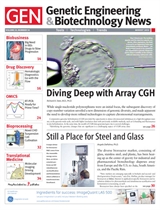Sep 27 2013
An international research team has shed light on the workings of a "Jekyll-and-Hyde" protein that sometimes encourages tumor cell growth while at other times suppresses it. The scientists describe in this week's issue of Molecular Cell their study of E2F, which is abnormal in the vast majority of cancers. They say they have an explaination for the dual nature E2F can assume in the body's cells, and they indicate how E2F could be a potent target for developing new cancer drugs.
Part of the team, based at Oxford University, has since carried out a drug discovery screen, and demonstrated that compounds that block the protein's change into "Mr. Hyde" result in the death of cancer cells. The other members of the investigative team hail from the Genome Institute of Singapore and the University of Texas MD Anderson Cancer Center.
"E2F-1 is a direct physical target for [the tumor suppressor protein] pRb, and a large body of evidence supports E2F-1 as a positive regulator of the cell cycle, particularly in activating genes required for S phase progression," wrote the scientists in the journal article ("Arginine methylation-dependent reader-writer interplay governs growth"). "In contrast, however, E2F-1 activity is also connected with a role in negatively regulating cell growth and apoptosis."
Nick La Thangue, Ph.D., of the department of oncology at Oxford University, said the mechanism discovered here for switching a key protein is extremely novel. "Nothing else I've come across behaves like it," he noted. "Subtle changes in terms of the chemistry of the protein have dramatic and polar opposite effects on the tumor cell, either allowing them to continuously grow or switching them to cell death mode. We are excited by this new discovery, which provides a new and very important approach to developing new types of cancer drugs. We have much work to do."
E2F is inextricably linked to cancer. It is normally tightly controlled in the cell cycle, but in most if not all cancer cells the processes E2F oversees go awry so that it keeps cells growing. Puzzlingly, while it can be a factor driving cancer, on other occasions E2F is protective and removes damaged cells. When normal cells experience damage, E2F is involved in switching the cell toward cell death in a process called apoptosis. This helps prevent the buildup of DNA errors and the development of cancer.
The research study showed that E2F is an important switch that determines cell fate. As Dr. Jekyll, when DNA damage is detected, it leads to cell death. As Mr. Hyde, it switches on cell growth and proliferation. In most if not all cancers, it is this function of E2F that lurches out of control.
The researchers show that two enzymes compete to attach a molecular label, or flag, on different parts of the E2F protein. The flag in one position sees E2F act to cause cell death, and the same flag in another position sees E2F boost cell growth and proliferation.
"It's like there's an angel and a devil competing to get on each shoulder of the protein," said Dr. La Thangue. "Which one gets the upper hand is able to whisper in the ear of the protein and tell it what it should do. With the molecular flag on one shoulder, E2F goes into cell kill mode. With the flag on the other, it goes into cell growth mode. The challenge is to mimic this process with drugs, and reinstate the death pathway in tumor cells."
In cancer cells, E2F gets stuck with the flag-boosting growth and division, helping drive the tumor's growth. The researchers identified another protein in the cell that looks for the presence of this flag. "Blocking this protein means the devil's whispers never get heard and E2F doesn't transform into Mr. Hyde," continued Dr. La Thangue. "Instead, E2F switches over to cell death mode and the cancer cells die out."
He added that the team has identified compounds as potential drug candidates that do the same thing.

 This article was reprinted from Genetic Engineering & Biotechnology News (GEN) with permission from Mary Ann Liebert, Inc., publishers. Genetic Engineering & Biotechnology News (GEN) has retained its position as the number one biotech publisher around the globe since its launch in 1981. GEN publishes a print edition 21 times a year and has additional exclusive editorial content online, like news and analysis as well as blogs, podcasts, webinars, polls, videos, and application notes. GEN's unique news and technology focus includes the entire bioproduct life cycle from early-stage R&D, to applied research including omics, biomarkers, as well as diagnostics, to bioprocessing and commercialization.
This article was reprinted from Genetic Engineering & Biotechnology News (GEN) with permission from Mary Ann Liebert, Inc., publishers. Genetic Engineering & Biotechnology News (GEN) has retained its position as the number one biotech publisher around the globe since its launch in 1981. GEN publishes a print edition 21 times a year and has additional exclusive editorial content online, like news and analysis as well as blogs, podcasts, webinars, polls, videos, and application notes. GEN's unique news and technology focus includes the entire bioproduct life cycle from early-stage R&D, to applied research including omics, biomarkers, as well as diagnostics, to bioprocessing and commercialization.